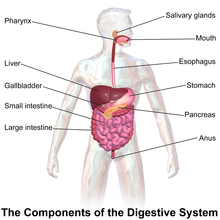Human Digestive System
Appearance

Introduction
[edit | edit source]The human body requires energy to function properly. Energy is obtained from the external environment by ingesting food. The digestive system’s main function is to transfer energy from food to cells; it breaks down food into small, accessible units called nutrients that cells can use. Unnecessary material is then excreted.
There are four processes that the digestive system performs to achieve its function.
- Motility: refers to the mixing and movement of food from the mouth to the anus with the help of smooth muscle that is found along the gastrointestinal tube.
- Secretion: the discharge of enzymes, water and other substances into the lumen of the digestive track by specialized tissues called exocrine glands.
- Digestion: the breakdown of food into smaller pieces or the degradation of large molecules into smaller ones.
- Absorption: the transport of nutrients in the blood or lymph to be circulated around the body.
The digestive system is a group of organs working together to convert food into energy. The digestive system consists of structures along the gastrointestinal tube such as the mouth, oesophagus, stomach, small intestines and large intestines, as well as accessory organs such as the salivary glands, pancreas, liver and gallbladder.
